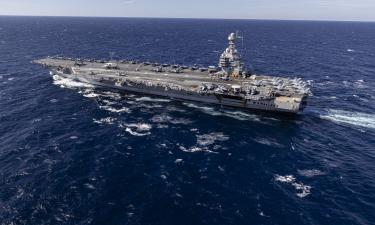ABM Treaty buried year ago
The USA was quitting the 1972 Treaty on the Limitation of Anti-Ballistic Missile Systems, better known as the ABM treaty. President George W. Bush officially announced the resolution a year ago this day, December 13, 2001. The treaty receded into history six months later, June 13 this year, though it was the basis of Russian-U.S. arrangements to control armaments and arsenal cuts, and was regarded as a cornerstone of strategic stability.
The Russian top was direly opposed to the treaty denunciation, and repeatedly referred to it as America's great blunder which might bring unpredictable fruit. However, Moscow did not do anything spectacular to counteract - with good reason, too. First, each signatory of the bilateral treaty had the sovereign right to leave it in case the partner was notified in due time. Second, Russia could not make America recall the decision or, at least, put off the move. Meanwhile, the White House had expected the Kremlin to agree to its repeated calls to update the treaty.
Moscow's stance on that point was quite different. As it saw the matter, to update the treaty was as good as bury it because the United States was calling to establish another area in which a national anti-missile system would be deployed, with each signatory to increase the number of its interceptor missiles. The U.S. option also aimed to authorise construction of more missile attack warning radars outside the signatory countries, and related R&D - and never mind that the arrangement would utterly distort the essence of the ABM treaty, which harshly limited anti-missile systems. In fact, the treaty modernisation would unleash the arms race, in which Russia did not mean to engage - and could not afford it, for that matter.
Even with Russia resolutely opposed to treaty updating, it was clear that the USA would cling to its idea of protecting itself from missile attacks, wherever they could come from. That was a tangible goal, considering American economic prosperity and huge research and technical opportunities. The USA was anxious to protect itself not only from the rogue countries - with North Korea, Iran, Iraq and certain other countries blacklisted as such - but from any other country which possessed missiles and nuclear arsenals. Russia was certainly among them, though the USA was always silent on that ticklish point.
The USA was making exorbitant NMD allocations for many years before it determined to bury the treaty. 95 billion dollars was spent on it between 1983, when President Ronald Reagan launched his programme for a Strategic Defence Initiative - popularly known as Star Wars - and 2001, when President George W. Bush announced that his country was banging the door on the ABM treaty. Anti-missile umbrella R&D never stopped even after the SDI receded into oblivion. At the start, the efforts did not considerably trespass related Russo-U.S. understandings.
A total of $4.5 billion was allocated to the purpose in the fiscal year 2001, and $8.3 billion this year. According to General Accounting Office estimates, no less than a hundred billion dollars will be necessary for future-oriented R&D on a mere two NMD areas - in North Dakota's Grand Forks and in Alaska. Surely, the USA felt tied hand and foot with the ABM treaty, so the treaty was doomed.
The latest ground antimissile missiles were tested on six occasions this year in Kwajalein of the Marshall islands in the Pacific. A greater part of the tests were a success. Americans have learned to tell real warheads from dummies, and hit them even above the atmosphere.
Russians do not have anything against those efforts. As experts of the military-industrial complex and military leaders said to RIA Novosti on several occasions, they are closely monitoring American R&D, and have not yet seen any fabulous NMD achievements. In fact, the USA is doing what the Soviet Union accomplished more than thirty years ago, so Russia has no grounds for apprehensions.
More than that, as the START III, made last May, guarantees, either signatory will cut its stock of nuclear warheads to 1,700-2,200 within the next ten years. The new treaty does not prevent Russia's efforts, known as asymmetrical measures, to enhance its security, so Moscow has a chance to compensate the gone ABM treaty with no big expenditures.
Those asymmetrical steps include a revision of blueprints to cut strategic offensive arsenals. Before the USA quit the ABM treaty, Russia was intending to put an end, before 2007, to its strategic group of 154 heavy R-36 Voivode missiles, known in the West as SS-18 Satan - each with ten MIRVs, which can break up any anti-missile defence. Now, Moscow has determined to leave them on the alert into 2012 or even 2015, that is, throughout their guaranteed and prolonged life.
Russia has suspended the reduction of railway-based RT-23 Molodets missile installations (SS-24 Scalpel, on Western classification), also with ten MIRVs each. Russia has an opportunity to install MIRVs on the latest silo-based RT-2 PM Topol-M (SS-25 Sickle) missiles. All that will compensate for an absence of agreements to limit anti-missile defence, expect the Kremlin and the Defence Ministry. A majority of experts share the opinion.
To supplement those measures, Russia is establishing a Special-Purpose Command on the basis of the Moscow district of the Air Force and the Anti-Aircraft Defence troops, Sergei Ivanov, Defence Minister, announced to the media. He described the new arrangement as "advance force of national air and space defence." It will bring together the Air Force, army anti-aircraft defence forces, and Space-based Forces, including the space rocket defence system, which incorporates the Moscow anti-missile defence network.
All those forces will start joint command and staff exercises early next year to work out patterns for a pioneer strategic operations command. It will not precisely repeat the arrangements of the United States' NMD command but will provide reliable air and space defence of at least one part of Russia. The endeavour does not threaten to be an unbearable burden on the Russian economy.
It will come as part of Russia's efficient, though undeclared, asymmetrical response to America after it quit the 1972 ABM treaty.
Subscribe to Pravda.Ru Telegram channel, Facebook, RSS!




